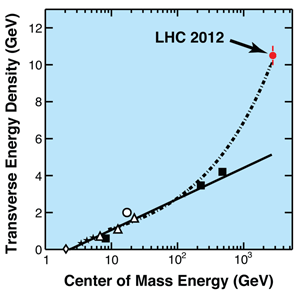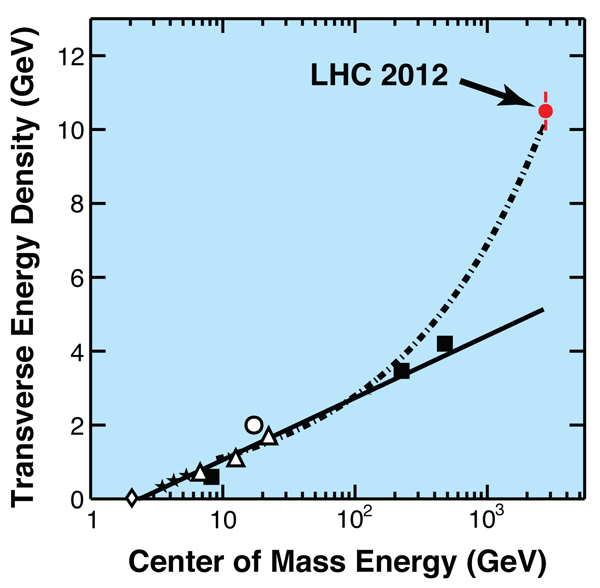New Measurements of the Most Perfect Liquid
For several years, researchers have known that the quark-gluon matter created in the collision of relativistic nuclei has an exceptionally low viscosity. Now, the latest experiments exploring this state of matter are being reported in Physical Review Letters by the collaboration running the Compact Muon Solenoid (CMS) detector at the Large Hadron Collider in Geneva. The team was able to study the quark-gluon matter at higher collision energies and for longer times compared to earlier experiments [1]. As a result, their data will lead to more accurate calculations of the viscosity and expansion of the strongly interacting matter and may help researchers better understand the structure of gluons in high-energy particles.
One of the main goals of high-energy nuclear physics is to break apart protons, neutrons, and heavier nuclei into their constituent quarks and gluons and study the state of matter believed to exist at the time of the big bang. But creating deconfined quarks and gluons, which are bound by the strong force, requires either very high temperatures or very high energies. At the Relativistic Heavy Ion Collider (RHIC), these conditions are created by smashing ultrarelativistic gold nuclei together, while collisions between lead nuclei are studied at the higher-energy Large Hadron Collider (LHC). Like other detector experiments, CMS measures the energies and momenta of the particles created in such collisions and uses this information to figure out the state of matter created shortly after the collision.
Earlier experimental findings at RHIC indicated that the matter produced in heavy-ion collisions expands like a fluid with very little dissipation. In fact, the dissipation approaches a fundamental lower limit for fluids, suggesting that the deconfined quark-gluon matter could be one of the most “perfect” fluids ever studied in the lab [2] (See 26 October 2010 Trends). The RHIC researchers reached this conclusion by studying the momentum anisotropy of particles produced in heavy-ion collisions. Typically, the geometry of the colliding nuclei determines the anisotropy, but how this spatial anisotropy is converted to momentum-space anisotropy depends on the shear viscosity: the smaller the shear viscosity the more efficient this conversion is. The RHIC experiments showed that the anisotropies are quite large, suggesting that the ratio of the shear viscosity to entropy density, ( ), in the quark-gluon matter is very small.
Heavy-ion collision experiments at the LHC are now aimed at understanding how the properties of quark-gluon matter, in particular , depend on the temperature or energy density, or whether there are significant effects from the relatively small size of the system produced in heavy-ion collisions. The energy density of the quark-gluon matter increases with the center-of-mass energy of the accelerated ions, while the size of the system is determined by the degree to which the ions strike each other head on (the centrality of the collision.) To characterize the geometry of the system produced in the heavy-ion collisions, researchers measure the rapidity, , of all of the post-collision particles. Here and are the energy of the particle and its momentum along the beam axis. Roughly speaking, the rapidity describes how fast particles are moving in the longitudinal direction (along the path of the collision) and is a useful way to describe the longitudinal distribution of the matter.
The particular quantity that CMS measures in the new experiments is the transverse energy density—the energy per particle of those particles that were ejected perpendicular to the line of collision. This quantity depends on two unknowns—the initial state of the collision (the moment right after the two nuclei collide) and the viscosity of the quark-gluon matter as it expands to the final state that CMS actually measures—and may therefore tell us something new about both.
One of the uncertainties in trying to quantify from heavy-ion collisions is an incomplete theoretical picture of the initial state. When a proton or nucleus is accelerated to high energies, the number of gluons inside of the particle increases. This occurs because the particle has more energy with which to generate new gluons, but eventually, there are so many gluons that they start to interact and annihilate each other. At some point, gluon creation and recombination balance out, the number of gluons saturates, and the interior of the particle is said to form a “color glass condensate.” Such a system can be described classically because it has a high occupation number of gluons [3].
When two heavy ions collide, the gluon fields in the two nuclei start to interact with each other. In a short window of time (up to about , where seconds), quantum fluctuations are small and the gluons can still be described classically [4]—a state called a glasma. In fact, it is the classical nature of the gluons fields at early times that makes the theoretical treatment of this highly nonlinear and nonequilibrium system possible. An energy scale that is called the gluon saturation scale characterizes both the color glass condensate and the glasma. The gluon saturation scale, , is and depends on the energy of the collisions and the rapidity, and this dependence is relatively straightforward to calculate [5,6]. For this reason, models based on the idea of gluon saturation have been successful at characterizing these quantities in heavy-ion collisions at RHIC as well as at the LHC [5,6]. But, there is still no consensus that the gluon saturation picture is applicable when is a relatively low value, as it is in the RHIC and LHC experiments.
CMS’s experiments show (Fig. 1) that the transverse energy density rises more rapidly with the collision energy than the lower-energy RHIC experiments had indicated. The result is not completely surprising if gluon saturation is the right theory for the initial state: The saturation scale depends nonlinearly on the center-of-mass energy because the gluon density isn’t linear with energy. Therefore the gluon saturation picture can, in principle, provide a natural explanation of the rapid rise of the transverse energy density seen in Fig. 1. Proton-lead collisions planned at the LHC will provide a more direct test of the gluon saturation picture. In the long run, the ultimate test will come from colliding electrons with heavy ions. (New facilities for such experiments, such as the Electron-Ion Collider in the US or the Large Hadron Electron Collider at CERN are currently being proposed.)
The new experiments are also important because they allow a more accurate measurement of the viscosity of deconfined quark-gluon matter. To relate the initial-state transverse energy density, which can be calculated in the framework of gluon saturation, to the final state that CMS actually measures, one has to smoothly match the calculation in the glasma framework to viscous hydrodynamics. The first attempts to do this studied the anisotropy of the flow of particles [7]. Based on the new CMS measurement, similar calculations should be able to determine the centrality and rapidity dependence of the transverse energy in the final state, thus providing additional constraints on the hydrodynamic models and the value of that are largely independent from those coming from anisotropic flow. CMS has provided the data, so now we’ll have to sit tight and wait for the calculations.
References
- S. Chatrchyan et al. (CMS Collaboration), “Measurement of the Pseudorapidity and Centrality Dependence of the Transverse Energy Density in Pb-Pb Collisions at sqrt(sNN)=2.76 TeV,” Phys. Rev. Lett. 109, 152303 (2012)
- Hunting the Quark Gluon Plasma, Results from the First 3 Years at RHIC, Assessments by the Experimental Collaborations, April 18, 2005, http://www.bnl.gov/bnlweb/pubaf/pr/docs/Hunting-the-QGP.pdf
- L. D. McLerran and R. Venugopalan, “Computing Quark and Gluon Distribution Functions for Very Large Nuclei,” Phys. Rev. D 49, 2233 (1994); “Gluon Distribution Functions for Very Large Nuclei at Small Transverse Momentum,” 49, 3352 (1994)
- T. Lappi and L. McLerran, “Some Features of the Glasma,” Nucl. Phys. A 772, 200 (2006)
- D. Kharzeev and M. Nardi, “Hadron Production in Nuclear Collisions at RHIC and High-Density QCD,” Phys. Lett. B 507, 121 (2001)
- A. Dumitru, D. E. Kharzeev, E. M. Levin, and Y. Nara, “Gluon Saturation in pA Collisions at Energies Available at the CERN Large Hadron Collider: Predictions for Hadron Multiplicities,” Phys. Rev. C 85, 044920 (2012)
- B. Schenke, P. Tribedy, and R. Venugopalan, “Fluctuating Glasma Initial Conditions and Flow in Heavy Ion Collisions,” Phys. Rev. Lett. 108, 252301 (2012); “Event-by-Event Gluon Multiplicity, Energy Density and Eccentricities at RHIC and LHC,” arXiv:1206.6805 (hep-ph); C. Gale, S. Jeon, B. Schenke, P. Tribedy, and R. Venugopalan, “Event-by-Event Anisotropic Flow in Heavy-Ion Collisions from Combined Yang-Mills and Viscous Fluid Dynamics,” arXiv:1209.6330 (nucl-th)





